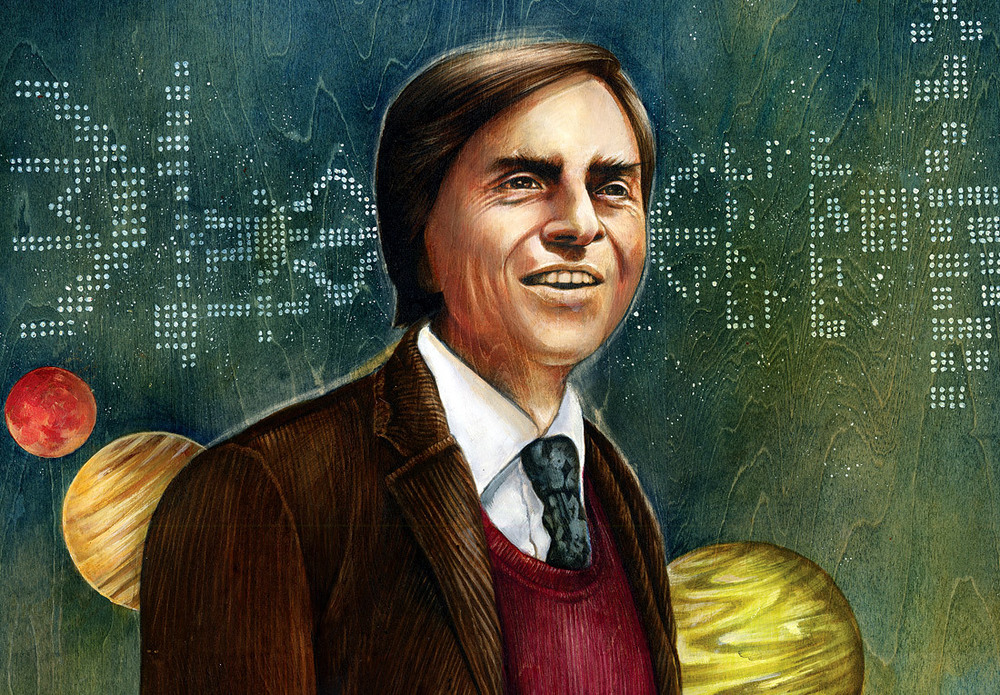Carl Sagan
Somewhere, something incredible is waiting to be known.

An American astronomer, cosmologist, astrophysicist, astrobiologist, author, science popularizer, and science communicator in astronomy and other natural sciences.
Biography
Carl Edward Sagan was an American astronomer, cosmologist, astrophysicist, astrobiologist, author, science popularizer, and science communicator in astronomy and other natural sciences. He is best known for his work as a science popularizer and communicator. His best known scientific contribution is research on extraterrestrial life, including experimental demonstration of the production of amino acids from basic chemicals by radiation. Sagan assembled the first physical messages sent into space: the Pioneer plaque and the Voyager Golden Record, universal messages that could potentially be understood by any extraterrestrial intelligence that might find them. Sagan argued the now accepted hypothesis that the high surface temperatures of Venus can be attributed to and calculated using the greenhouse effect.
Sagan published more than 600 scientific papers and articles and was author, co-author or editor of more than 20 books. He wrote many popular science books, such as The Dragons of Eden, Broca's Brain and Pale Blue Dot, and narrated and co-wrote the award-winning 1980 television series Cosmos: A Personal Voyage. The most widely watched series in the history of American public television, Cosmos has been seen by at least 500 million people across 60 different countries. The book Cosmos was published to accompany the series. He also wrote the science fiction novel Contact, the basis for a 1997 film of the same name. His papers, containing 595,000 items, are archived at The Library of Congress.
Sagan advocated scientific skeptical inquiry and the scientific method, pioneered exobiology and promoted the Search for Extra-Terrestrial Intelligence (SETI). He spent most of his career as a professor of astronomy at Cornell University, where he directed the Laboratory for Planetary Studies. Sagan and his works received numerous awards and honors, including the NASA Distinguished Public Service Medal, the National Academy of Sciences Public Welfare Medal, the Pulitzer Prize for General Non-Fiction for his book The Dragons of Eden, and, regarding Cosmos: A Personal Voyage, two Emmy Awards, the Peabody Award and the Hugo Award. He married three times and had five children. After suffering from myelodysplasia, Sagan died of pneumonia at the age of 62, on December 20, 1996.
Famous Quotes
One of the saddest lessons of history is this: If we’ve been bamboozled long enough, we tend to reject any evidence of the bamboozle. We’re no longer interested in finding out the truth. The bamboozle has captured us. It’s simply too painful to acknowledge, even to ourselves, that we’ve been taken. Once you give a charlatan power over you, you almost never get it back.
The absence of evidence is not the evidence of absence.
If you look at Earth from space you see a dot, that's here. That's home. That's us. It underscores the responsibility to deal more kindly and compassionately with one another and to preserve and cherish that pale blue dot, the only home we've ever known.
I don't want to believe. I want to know.
Better the hard truth, I say, than the comforting fantasy.
We are like butterflies who flutter for a day and think it is forever.
It is far better to grasp the universe as it really is than to persist in delusion, however satisfying and reassuring.
There are in fact 100 billion galaxies, each of which contain something like a 100 billion stars. Think of how many stars, and planets, and kinds of life there may be in this vast and awesome universe.
Imagination will often carry us to worlds that never were. But without it we go nowhere.
If we continue to accumulate only power and not wisdom, we will surely destroy ourselves
Awards and Honors
- Annual Award for Television Excellence—1981—Ohio State University—PBS series Cosmos: A Personal Voyage
- Apollo Achievement Award—National Aeronautics and Space Administration
- NASA Distinguished Public Service Medal—National Aeronautics and Space Administration
- Emmy—Outstanding Individual Achievement—1981—PBS series Cosmos: A Personal Voyage
- Emmy—Outstanding Informational Series—1981—PBS series Cosmos: A Personal Voyage
- Exceptional Scientific Achievement Medal—National Aeronautics and Space Administration
- Helen Caldicott Leadership Award – Awarded by Women's Action for Nuclear Disarmament
- Hugo Award—1981—Best Dramatic Presentation—Cosmos: A Personal Voyage
- Hugo Award—1981—Best Related Non-Fiction Book—Cosmos
- Hugo Award—1998—Best Dramatic Presentation—Contact
- Humanist of the Year—1981—Awarded by the American Humanist Association
- American Philosophical Society—1995—Elected to membership
- In Praise of Reason Award—1987—Committee for Skeptical Inquiry
- Isaac Asimov Award—1994—Committee for Skeptical Inquiry
- John F. Kennedy Astronautics Award—1982—American Astronautical Society
- Special non-fiction Campbell Memorial Award—1974—The Cosmic Connection: An Extraterrestrial Perspective
- Joseph Priestley Award—"For distinguished contributions to the welfare of mankind"
- Klumpke-Roberts Award of the Astronomical Society of the Pacific
- Konstantin Tsiolkovsky Medal—Awarded by the Soviet Cosmonauts Federation
- Locus Award 1986—Contact
- Lowell Thomas Award—The Explorers Club—75th Anniversary
- Masursky Award—American Astronomical Society
- Miller Research Fellowship—Miller Institute (1960–1962)
- Oersted Medal—1990—American Association of Physics Teachers
- Public Welfare Medal—1994—National Academy of Sciences
- Pulitzer Prize for General Non-Fiction—1978—The Dragons of Eden
- Science Fiction Chronicle Award—1998—Dramatic Presentation—Contact
- Named an honorary member of the Demosthenian Literary Society on November 10, 2011
- New Jersey Hall of Fame—2009—Inductee
- Committee for Skeptical Inquiry (CSI) Pantheon of Skeptics—April 2011
~
"The nitrogen in our DNA, the calcium in our teeth, the iron in our blood, the carbon in our apple pies were made in the interiors of collapsing stars. We are made of starstuff."
Learn more about the famous scientist on his ikipedia page.